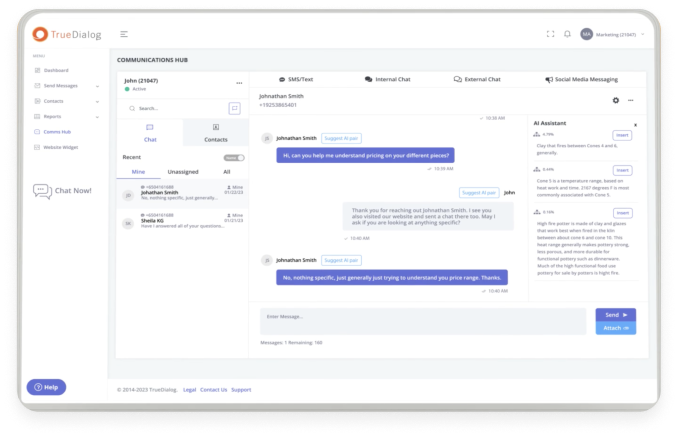If you’re a business already texting prospects and customers, you have likely been hearing more about 10DLC SMS, or 10-Digit Long Code. Carriers will be terminating shared short codes by June 2021, requiring businesses to convert to dedicated short codes or 10DLC.
Wondering what the differences are between shared short codes, dedicated short codes, and 10DLC SMS? Let’s break each of them down.
What Are Shared Short Codes?
Shared short codes are the least expensive way to text with your audience. The codes are typically five or six numbers and thousands of businesses share the same code. While they are more affordable than dedicated codes and allow you to send large volumes of texts nearly instantaneously, they open your business up to risks.
They are one-way messages
First of all, shared short codes are useful for one-way messaging only. It’s you sending your customers and prospects a promotion, alert, general information or the like without the expectation of a response. Like a mailer or email from a “donotreply” address, you aren’t engaging in a conversation.
They make finding unique keywords challenging
Then, there’s the issue with keywords. Each company must come up with a unique keyword with each SMS marketing campaign, one that none of the thousands of companies sharing that code are using. Not always an easy task.
For instance, let’s say you are a pizza restaurant and want to run a marketing campaign to get people to download your new ordering app. Using your mass text app for business, you plan to text your target audience a promo to get 20% off their next order by reply to your text with the keyword, “PIZZA.”
Related: How to Use Enterprise Text Messaging Software (with Tips)
Sounds like a logical keyword until you discover another pizza chain is already using it. You then choose “CHEESE,” but then discover that won’t work, either. A photography company claimed that keyword. With thousands of businesses sharing your code, you can see what a pain those keywords become, limiting your creativity and delaying campaign launches.
You share risk with thousands of other companies
Another issue is it only takes one misstep from a company sharing your code to ruin it for everyone. If they don’t obey the rules, sending out inappropriate spam messages, for instance, the carrier may terminate the shared code entirely, blocking all users from sending another message from that shared short code. Imagine running an SMS texting campaign and without notice, the number no longer works.
Say Goodbye to Shared Short Codes
Shared short codes may be a relatively inexpensive way to engage with your audience, but they clearly present obstacles, much more so than 10DLC SMS. The sticking point for service providers is the fact that because they are one-way messages, they are spam. Much like an email filtering system detects spam messages and automatically directs them to a junk or spam folder, wireless carriers set up filters to protect mobile subscribers from spam.
Why do carriers care about spam messages? Security threats and customer complaints. While many spam messages are innocent enough, some are dangerous phishing attempts to trick unknowing mobile phone users to reply with sensitive personal information or click on a link that installs malware on the phone.
Every customer service call costs the carrier money. It’s also quite expensive for the carrier to deal with the high traffic coming in from spam messages. And what happens when you send an unsolicited message? You may find yourself at the other end of a TCPA violation, costing up a minimum of $500 per message.
Free Download: “TCPA Compliance: Marketing vs. Informational Calls and Text Messages” webinar
In an effort to reduce these types of messages, carriers are doing away with shared short codes. Other codes can still contain spam, but the shared short codes are a big step towards reducing spam messages.
Enter 10DLC SMS
In the place of shared short codes, carriers are encouraging businesses to use 10DLC numbers. Unlike more expensive dedicated short codes, the limited capacity toll-free long codes, or person-to-person local long codes, 10DCL SMS is relatively inexpensive and ideal for high-volume mass texting.
Carriers sanction 10DLC SMS numbers, giving you peace of mind your messages make it to their intended audience. And those keywords? Your 10DLC SMS number is like a business phone number. No one else uses it but you, enabling you to select keywords most appropriate for your campaign without worrying about finding a unique one.
What About Dedicated Short Codes?
Dedicated short codes are five or six-digit codes you either get to select (as with vanity short codes) or allow the carrier to randomly select for you based on availability (as with non-vanity short codes). Either way, the code is yours and yours alone. You will not share the code with any other business and retain control over its usage. You also have the freedom to choose any keyword you desire for your campaigns.
The downside? Cost. Vanity short codes are the most expensive type of SMS number, but it also gives you the ability to choose a code people will recognize as yours. For example, you could select an easy-to-remember code with relevance to your brand. McDonald’s uses the vanity short code “58585” – super easy to recall.
For smaller and midsize businesses, the 10DLC SMS or non-vanity short code option is likely more cost-effective. An added benefit of 10DLC is that you can convert your existing business landline number to 10DLC, giving you the ability to send and receive both calls and texts from one number without paying for an additional SMS text number.
Get The Most Impact: Use Both Short and Long-Code SMS Texting
Dedicated short codes and 10DLC SMS or other long codes are both effective communication tools with differing benefits. Used together, you have a powerful, unified platform to engage with prospects and customers.
Because they are easy to remember, have a fast SMS delivery speed, and typically pass the spam test during your application process, dedicated short codes are ideal for mass marketing campaigns. Companies often use them for text blasts to thousands of customers or prospects for advertising, promotions, customer loyalty programs, payment reminders, alerts, surveys and political messages.
Long codes like 10DLC SMS take a bit longer to send but look like they come from a real business, making them more appropriate for one-on-one customer service texts when you want to provide a personalized customer experience. They are ideal for sending appointment reminders, delivery updates, and engaging in issue resolution.
Which Mass Text App Is Best for Businesses?
Most mass text apps for business offer one type of code or the other, or more likely, lack the ability to connect the two into a unified platform. More innovative providers enable you to send mass text messages using a dedicated short code and then engage in one-to-one conversations at scale using an SMS long code or 10DLC SMS number – all in one thread.
Combining long code and short code messages into a single thread takes your customer service to the next level. Multiple agents from your customer service and call center can serve the customer, joining in on the same texting dialog to create a seamless customer experience.
Here’s why finding a mass texting app that supports both short codes and long codes is essential. Using the pizza company’s new app campaign example mentioned above, let’s say you decide to invest in both a dedicated short code and 10DLC SMS or other long code.
For mass texts to hundreds of thousands of consumers and advertisement of the 20% off promo in national or regional TV and radio commercials and printed media, you would leverage the convenience of a simple 5-6 digit code and the “PIZZA” keyword. Even better, you could ask recipients to text their zip codes to the short code, enabling one of your local pizza restaurants in or near that zip code to personally text them back for order and delivery.
The short code is easier to remember than a 10 digit phone number. Users also tend to recognize short codes as being more professional and less spammy because they are much harder and expensive to procure. Short codes have an 80-90% higher throughput than 10DLC, so you can send out as many mass texts as you want with greater assurance your texts made it to their intended recipients.
Using the long code, you can then engage in personalized and local text conversation that includes the ability for consumers to call the number as well, something you can’t do with call short codes.
Marketing utilizes short codes for more successful and efficient campaigns, and sales and customer service use long codes for more personalized, one-on-one interactions on the channel customers prefer.
Shared short codes may be disappearing, but you have plenty of options to effectively communicate with your customers and prospects. Dedicated short codes, 10DLC SMS and other long codes are safer and have more flexibility. Used together, you have an exceptional engagement platform to build brand awareness, drive sales, and delight your customers. Give TrueDialog a test drive for free.





